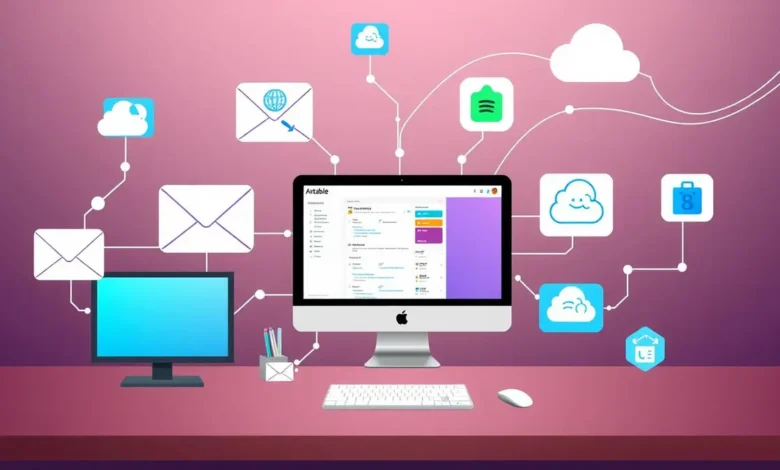Microsoft Airtable: Unlocking Seamless Collaboration and Productivity

Introduction
In the evolving world of digital collaboration and cloud-based tools, Microsoft Airtable has surfaced as a dynamic and versatile solution that enables teams to work more effectively. Combining the organizational prowess of spreadsheets with the accessibility and collaborative features of cloud technology, Microsoft Airtable is quickly becoming an essential tool for teams of all sizes. Its flexibility allows it to be used across a variety of industries, from project management and content planning to tracking customer relationships and automating workflows.
This article delves into the capabilities and potential of Microsoft Airtable, exploring how it can be integrated into daily workflows and the benefits it brings to businesses. We will unpack the features that make Microsoft Airtable unique, compare it to other tools in the market, and discuss why its seamless integration with Microsoft’s suite of products offers a competitive edge for businesses looking to streamline their operations.
Understanding Microsoft Airtable: A Hybrid Tool for the Modern Workspace
Microsoft Airtable represents a shift in how businesses think about collaboration and project management. While traditional spreadsheets have long been a staple of data organization, they lack the modern features necessary for real-time collaboration and customization. Microsoft Airtable bridges this gap, offering users a platform that looks and feels like a spreadsheet but operates with the flexibility and power of a relational database.
With Microsoft Airtable , users can create highly customized workflows, link related data sets, create automated workflows, and manage tasks more effectively than they could with traditional tools. Whether you’re tracking project deliverables, managing an editorial calendar, or keeping tabs on sales pipelines, Microsoft Airtable provides a user-friendly interface that’s adaptable to virtually any business process.
Its ability to integrate with existing Microsoft tools like Teams, SharePoint, and Outlook also enhances its appeal. For businesses already within the Microsoft ecosystem, Airtable’s seamless integration allows for more efficient workflows without the need to jump between platforms. This hybrid tool isn’t just a modern alternative to spreadsheets; it’s a collaboration powerhouse that enables businesses to centralize their operations in one cohesive environment.
Key Features of Microsoft Airtable: What Sets It Apart
One of the most compelling aspects of **Microsoft Airtable** is its combination of simplicity and sophistication. At first glance, it looks like a regular spreadsheet, but a deeper dive reveals its powerful database functionalities. The user experience is intuitive, making it easy for those familiar with Excel to quickly get started, but with far greater capabilities in terms of data linking and visualization.
Airtable offers multiple views, including grid, kanban, gallery, and calendar, allowing teams to visualize their work in the way that makes the most sense for them. The ability to switch between views ensures that teams can manage complex projects without losing track of important details. It also supports attachments, making it possible to embed files directly into records, reducing the clutter of external links and emails.
Another standout feature of Microsoft Airtable is its **collaborative environment**. Team members can collaborate in real time, adding comments, updating records, and assigning tasks without worrying about version control issues. Automated notifications and reminders can be set up to ensure that everyone is kept in the loop, promoting accountability and transparency across teams.
Microsoft Airtable vs. Competitors: Why It Stands Out
There are many project management and collaboration tools available in today’s market, so how does **Microsoft Airtable** stack up against the competition? One of the most notable differences is its balance between structure and flexibility. While platforms like Excel provide a rigid grid, and task managers like Trello focus solely on visualization, Microsoft Airtable offers the best of both worlds.
Compared to traditional spreadsheets like Excel, Airtable allows users to link data across tables, mimicking relational databases in a way that Excel simply cannot match. This makes it ideal for businesses that need to track more complex relationships between data sets, such as customer management, product inventories, or content pipelines.
When compared to other database-centric tools like Smartsheet or Google Sheets, Microsoft Airtable excels with its user-friendly interface and accessibility. The ability to customize the appearance and interaction with data makes it highly adaptable for a wide range of use cases. Additionally, Airtable’s integration with Microsoft tools gives it a significant advantage over competitors, making it easier for users who are already embedded in the Microsoft ecosystem to streamline their operations without adding unnecessary complexity.
Maximizing Productivity with Microsoft Airtable Automation

One of the Microsoft Airtable most transformative features of is its automation capabilities. These automations allow teams to eliminate repetitive tasks, ensuring that time and energy are directed toward more valuable activities. Users can set up triggers to automatically move data between records, send notifications, or update statuses when certain conditions are met.
Automation in Microsoft Airtable can range from simple tasks, such as updating a status column when a task is marked as complete, to more complex workflows, such as notifying an entire team when a milestone is reached in a project. By reducing manual input, teams can ensure that projects remain on track without unnecessary delays.
Additionally, Microsoft Airtable’s integration with Power Automate takes its automation capabilities to the next level. With Power Automate, teams can create sophisticated workflows that span across multiple Microsoft products, ensuring that information is seamlessly passed between tools like SharePoint, OneDrive, and Teams. This level of integration simplifies workflows and boosts overall productivity by eliminating redundant steps.
Integration with Microsoft 365: A Powerful Combination
One of the key advantages of **Microsoft Airtable** is its seamless integration with the rest of the Microsoft 365 suite. Whether you are using Outlook, Teams, or SharePoint, Airtable integrates effortlessly into the Microsoft environment, making it easier for businesses to collaborate and share information across departments.
For instance, project managers can embed Airtable bases directly into Teams channels, allowing team members to view and edit project data without leaving the Teams interface. This reduces the need to switch between applications, improving efficiency and enabling better communication among team members.
Furthermore, integration with Outlook means that users can automatically sync tasks, events, and project timelines, ensuring that important deadlines aren’t missed. By centralizing communication and data management within Microsoft’s ecosystem, businesses can simplify their workflows and reduce the friction that comes with managing multiple platforms.
Collaboration and Customization: The Heart of Microsoft Airtable
Collaboration is at the core of **Microsoft Airtable**, making it an essential tool for businesses that rely on cross-functional teamwork. With Airtable, teams can collaborate in real-time, assigning tasks, sharing files, and discussing progress without leaving the platform. This level of collaboration ensures that everyone is on the same page, eliminating silos and improving team dynamics.
What sets Airtable apart is its high level of customization. Teams can tailor their workspaces to fit the exact needs of their projects, whether they need a simple grid for task tracking or a more complex database for managing client information. Custom fields, formulas, and views enable teams to adapt their workflows to match their business processes, making Airtable an incredibly versatile tool.
Additionally, Airtable’s permission settings allow managers to control who can view or edit specific data, ensuring that sensitive information is protected while still promoting collaboration. This flexibility is especially valuable for businesses working on large projects with multiple stakeholders, as it allows for more granular control over who has access to different parts of a project.
Enhancing Project Management with Microsoft Airtable
Project management is one of the most common use cases for **Microsoft Airtable**, and for good reason. Its customizable grids and collaborative features make it an ideal solution for managing everything from small team projects to large-scale initiatives. Teams can use Airtable to plan, execute, and track the progress of their projects, ensuring that milestones are met and objectives are achieved.
Airtable’s Kanban view is particularly useful for project managers who want to visualize their projects in a way that promotes workflow transparency. Tasks can be easily moved from one stage to another, providing a clear view of what’s in progress and what’s completed. This visual approach to project management helps teams stay organized and ensures that everyone has a clear understanding of their responsibilities.
Furthermore, Microsoft Airtable’s integration with other project management tools, such as Microsoft Project, allows teams to combine their data for a more holistic view of project timelines and resource allocation. This level of integration enables project managers to make more informed decisions, ensuring that projects stay on time and within budget.
Managing Data with Microsoft Airtable: A New Approach
Data management is a critical part of any business, and **Microsoft Airtable** offers a new approach to handling complex data sets. Unlike traditional spreadsheets that are limited by rows and columns, Airtable allows users to link related data, creating relationships that mimic a relational database. This is particularly valuable for businesses that need to manage multiple data sets, such as customer information, product inventories, or marketing campaigns.
With Airtable, data can be easily filtered, sorted, and grouped based on specific criteria, allowing users to view the information that’s most relevant to them. The ability to link records between tables also reduces the need for duplicate data entry, improving accuracy and saving time.
Moreover, Airtable’s integrations with data analysis tools, such as Power BI, give businesses the ability to generate in-depth reports and gain insights from their data. By combining Airtable’s intuitive interface with powerful analytics tools, businesses can make more data-driven decisions, ensuring that they are leveraging their information to its fullest potential.
Streamlining Workflows with Microsoft Airtable
Efficient workflows are essential for business success, and **Microsoft Airtable** excels in helping teams streamline their processes. Whether it’s automating routine tasks or centralizing project data, Airtable’s flexible design enables teams to build workflows that match their specific needs.
For instance, teams can set up workflows to automatically assign tasks, notify team members of project updates, or generate reports based on real-time data. This level of automation not only saves time but also reduces the risk of human error, ensuring that processes run smoothly from start to finish.
By integrating with tools like Power Automate, Microsoft
Airtable can also connect with other Microsoft services, creating end-to-end workflows that span across multiple platforms. This level of integration allows businesses to automate entire processes, from the initial data entry to the final report generation, resulting in significant time savings and improved productivity.
Conclusion: The Future of Collaboration with Microsoft Airtable
As businesses continue to embrace digital transformation, tools like **Microsoft Airtable** are becoming essential for fostering collaboration and improving productivity. Its hybrid design, combining the familiarity of spreadsheets with the power of a relational database, makes it a versatile solution for businesses of all sizes.
Whether you’re managing projects, tracking customer data, or automating workflows, Microsoft Airtable offers a flexible, user-friendly platform that can adapt to your business needs. Its seamless integration with the Microsoft 365 suite ensures that teams can collaborate more effectively, while its advanced features allow businesses to manage data in ways that were previously impossible with traditional tools.
In summary, Microsoft Airtable represents the future of collaboration, offering businesses a powerful tool for organizing, managing, and automating their workflows. Its combination of flexibility, automation, and integration makes it a valuable addition to any business looking to improve efficiency and stay ahead in a competitive market.





